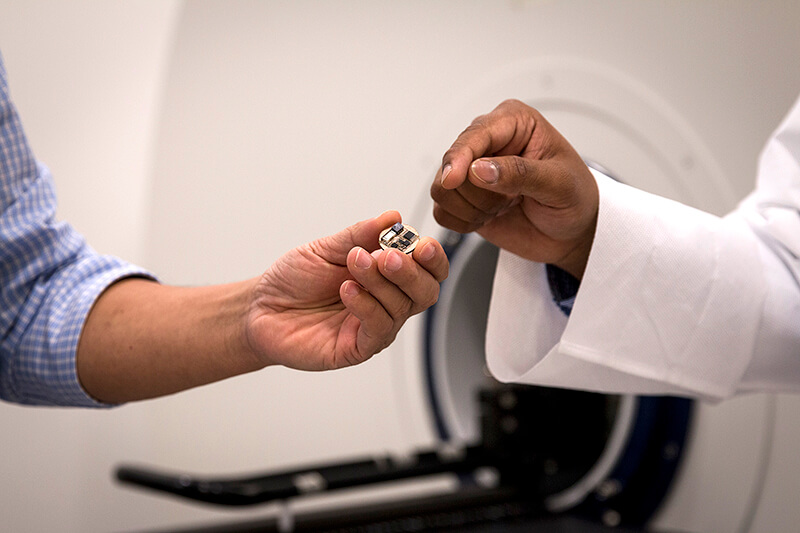July 18
MRI device could bridge neuro-technologies for medical diagnostics, increase patient safety
 Researchers from Purdue’s College of Engineering are developing a device that when placed into existing MRI machines could allow medical professionals to perform concurrent medical imaging and recording simultaneously. The technology would allow a more effective and safe way to monitor patients for diagnostic purposes. (Shannon Kane / Purdue Research Foundation Image)
Download image
Researchers from Purdue’s College of Engineering are developing a device that when placed into existing MRI machines could allow medical professionals to perform concurrent medical imaging and recording simultaneously. The technology would allow a more effective and safe way to monitor patients for diagnostic purposes. (Shannon Kane / Purdue Research Foundation Image)
Download image
WEST LAFAYETTE, Ind. – A technology being developed at Purdue University could provide an affordable, smart, self-learning device that, when placed into existing MRI machines could allow medical professionals to monitor patients more effectively and safely, by performing concurrent medical imaging and recording for diagnostic purposes.
Purdue researchers recently presented their findings, “Multimodal Imaging: MR-Compatible, Gradient Artifact free, Wireless recording system integrated with MR-scanner for Simultaneous EEG and fMRI acquisition,” at the International Society for Magnetic Resonance in Medicine conference in Honolulu, Hawaii. The article also received an ISMRM magna cum laude merit award, and power-pitch highlight, for highly-rated scientific merits. The article is available upon request.
The technology was developed by Ranajay Mandal and Nishant Babaria, graduate research assistants in Purdue’s College of Engineering, under the supervision of Zhongming Liu, an assistant professor in the Weldon School of Biomedical Engineering and the School of Electrical and Computer Engineering.
“MRI is a very common imaging tool, used in every medical domain to produce high-resolution information about the body and organs,” Babaria said. “However, when a patient is receiving an MRI scan, it is very difficult to also monitor brainwaves, ECG, or other biological signals. MRI alone does not always provide enough information to clinicians. There is tremendous scientific and clinical value in using multiple technologies together on a single platform.”
The technology being developed could work simultaneously with any MRI system to record electro-physiological signals during MRI scanning. The device aims to learn when to start and stop recording to capture useful signals during MRI operation.
“What we’ve developed is a small device that can be placed in an MRI system to serve as a platform to combine all other imaging technologies,” Mandal said. “This way the patient can be monitored for more than one diagnostic result at a time and researchers and doctors are able to obtain much more information all at once.”
Liu said the device could also reduce health risks and provide better imaging.
“Our device has a smaller footprint than a penny and could be used safely inside an MRI,” he said. “Although small, the device is very powerful and allows researchers to record, stimulate, and image the brain or other organs all through the MRI system.”
Nishant said the device also has additional features.
“We believe this device is the first of its kind. It’s wireless and directly powered and operated by the MRI. It is much more affordable than other commercial systems, and provides much better quality in neural recording and stimulation during MRI imaging,” he said. “The device has great potential to significantly improve the safety, efficacy, and precision of medical diagnostics for patients who suffer from epilepsy, Parkinson’s diseases, depression, and many more diseases.”
The technology is patented through the Purdue Research Foundation Office of Technology Commercialization.
Mandal and Babaria said they received great feedback from the conference.
“Several people, from almost a dozen universities, requested the device for their own research,” Babaria said. “We’re eager to move forward with testing so that we can finalize and get the device in the hands of those who need it.”
About Purdue Office of Technology Commercialization
The Purdue Office of Technology Commercialization operates one of the most comprehensive technology transfer programs among leading research universities in the U.S. Services provided by this office support the economic development initiatives of Purdue University and benefit the university's academic activities. The office is managed by the Purdue Research Foundation, which received the 2016 Innovation and Economic Prosperity Universities Award for Innovation from the Association of Public and Land-grant Universities. For more information about funding and investment opportunities in startups based on a Purdue innovation, contact the Purdue Foundry at foundry@prf.org. For more information on licensing a Purdue innovation, contact the Office of Technology Commercialization at innovation@prf.org.
Purdue Research Foundation contact: Hillary Henry, 765-588-3586, hkhenry@prf.org
Sources: Ranajay Mandal, rmandal@purdue.edu
Nishant Babaria, nbabaria@purdue.edu
Zhongming Liu, zmliu@purdue.edu
Note to Journalists: A copy of the research paper is available from Hillary Henry, Purdue Research Foundation, at 765-588-3586, hkhenry@prf.org.
ABSTRACT
Multimodal Imaging: MR-Compatible, Gradient Artifact free, Wireless recording system integrated with MR-scanner for Simultaneous EEG and fMRI acquisition
Ranajay Mandal1, Nishant Babaria2, Jiayue Cao1, and Zhongming Liu1,2
1Biomedical Engineering, Purdue University, West Lafayette, IN, United States, 2Electrical and Computer Engineering, Purdue University, West Lafayette, IN, United States
The field of multimodal imaging has largely been propelled by two of the most widely used neuroimaging tools, fMRI and EEG, as the complementary nature of the two signals provides a unique avenue to evaluate the brain dynamics and its underlying neural circuitry. However, methodological challenges associated with simultaneous acquisition of EEG and fMRI impedes the method from achieving the full potential. To address these challenges, we present an MR-compatible, active recording system that utilizes surplus MR-hardware and inherent electromagnetic field to synchronize and wirelessly record gradient artifact free multichannel EEG signals and encode these Non-MR signals within the extended FOV of the MR image.

